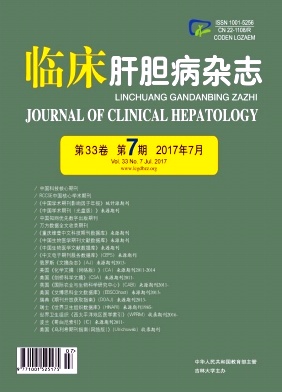|
[1]MEDIA CENTRE.Title of subordinate document.In:Cancer, 2015[EB/OL]. (2015-02-18) http//www.who.int/mediacentre/factsheets/fs297/en/.
|
|
[2]KOH KC, LEE H, CHOI MS, et al.Clinicopathologic features and prognosis of combined hepatocellular cholangiocarcinoma[J].Am JSurg, 2005, 189 (1) :120-125.
|
|
[3]WANG J, WANG F, KESSINGER A.Outcome of combined hepatocellular and cholangiocarcinoma of the liver[J].J Oncol, 2010, 2010:917356.
|
|
[4]ERTLE JM, HEIDER D, WICHERT M, et al.A combination of alpha-fetoprotein and des-gamma-carboxy prothrombin is superior in detection of hepatocellular carcinoma[J].Digestion, 2013, 87 (2) :121-131.
|
|
[5]YANG H, ZHAI G, JI X, et al.LAPTM4B allele*2 is a marker of poor prognosis following hepatic tumor resection for hepatocellular carcinoma[J].PLo S One, 2012, 7 (4) :e34984.
|
|
[6]JOHNSON R, HALDER G.The two faces of Hippo:targeting the Hippo pathway for regenerative medicine and cancer treatment[J].Nat Rev Drug Discov, 2014, 13 (1) :63-79.
|
|
[7]HARVEY KF, ZHANG X, THOMAS DM.The Hippo pathway and human cancer[J].Nat Rev Cancer, 2013, 13:246-257.
|
|
[8]MENG Z, MOROISHI T, GUAN KL.et al.Mechanisms of Hippo pathway regulation[J].Genes Dev, 2016, 30 (1) :1-17.
|
|
[9]DING R, KEVIN W, TORSTEN B.The Hippo signalling pathway maintains quiescence in Drosophila neural stem cells[J].Nat Commun, 2016, 7:10510.
|
|
[10]KIM JE, FINLAY GJ, BAGULEY BC.The role of the hippo pathway in melanocytes and melanoma[J].Front Oncol, 2013, 3:123.
|
|
[11]KOMURO A, NAGAI M, NAVIN NE et al.WW domain-containing protein YAP ssociateswith Erb B-4 and acts as a co-transcriptional activator for the carboxyl-terminal ragment of Erb B-4that translocates to the nucleus[J].J Biol Chem, 2003, 278:33334-33341.
|
|
[12]NALLET-STAUB F, MARSAUD V, LI L, et al.Pro-invasive activity of the Hippo pathway effectors YAP and TAZ in cutaneous melanoma[J].J Invest Dermatol, 2014, 134 (1) :123.
|
|
[13]MORVARIDI S, DHALL D, GREENE M, et al.Role of YAP and TAZ in pancreatic ductal adenocarcinoma and in stellate cells associated with cancer and chronic pancreatitis[J].Sci Rep, 2015, 16 (5) :16759.
|
|
[14]ZENDER L, SPECTOR MS, XUE W, et al.Identification and validation of oncogenes in liver cancer using an integrative oncogenomic approach[J].Cell, 2006, 125:1253-1267.
|
|
[15]CHUNBO HE, DAGAN MAO, GUOHUA HUA, et al.The Hippo/YAP pathway interacts with EGFR signaling and HPV oncoproteins to regulate cervical cancer progression[J].EMBO Mol Med, 2015, 7 (11) :1426-1449.
|
|
[16]MAUGERI-SACCM, BARBA M, PIZZUTI L, et al.The Hippo transducers TAZ and YAP in reast cancer:oncogenic activities and clinical implications[J].Expert Rev Mol Med, 2015, 17:e14.
|
|
[17]WANG Y, DONG Q, ZHANG Q, et al.Overexpression of yesassociated protein contributes to progression and poor prognosis of nonsmall-cell lung cancer[J].Cancer Sci, 2010, 101 (5) :1279-1285.
|
|
[18]KANG W, TONG JH, CHAN AW.Yes-associated protein 1 exhibits oncogenic property in gastric cancer and its nuclear accumulation associates with poor prognosis[J].Clin Cancer Res, 2011, 17 (8) :2130-2139.
|
|
[19]AVRUCH J, ZHOU D, BARDEESY N.YAP oncogene overexpression supercharges colon cancer proliferation[J].Cell Cycle, 2012, 11 (6) :1090-1096.
|
|
[20]KIM M, KIM T, JOHNSON RL, et al.Transcriptional co-repressor function of the hippo pathway transducers YAP and TAZ[J].Cell Rep, 2015, 11 (2) :270-282.
|
|
[21]WANG Y, XIE C, LI Q, et al.Clinical and prognostic significance of Yes-associated protein in colorectal cancer[J].Tumor Biol, 2013, 34 (4) :2169-2174.
|
|
[22]ZHAO B, WEI X, LI W, et al.Inactivation of YAP oncoprotein by the Hippo pathway is involved in cell contact inhibition and tissue growth control[J].Genes Dev, 2007, 21:2747-2761.
|
|
[23] XU MZ, YAO TJ, LEE NP, et al.Yes-associated protein is an independent prognostic marker in hepatocellular carcinoma[J].Cancer, 2009, 115 (9) :4576-4585.
|
|
[24]DONG J, FELDMANN G, HUANG J, et al.Elucidation of a universal size-control mechanism in Drosophila and mammals[J].Cell, 2007, 130 (6) :1120-1133.
|
|
[25]ZHAO B, YE X, YU J, et al.TEAD mediates YAP-dependent gene induction and growth control[J].Genes Dev, 2008, 22:1962-1971.
|
|
[26]HEN L, LOH PG, SONG H.Structural and functional insights into the TEAD-YAP complex in the Hippo signaling pathway[J].Protein Cell, 2010, 1 (12) :1073-1083.
|
|
[27]VISSERGRIEVE S, ZHOU Z, SHE YM, et al.LATS1 tumor suppressor is a novel actin-binding protein and negative regulator of actin polymerization[J].Cell Res, 2011, 21 (10) :1513-1516.
|
|
[28] DONG J, FELDMANN G, HUANG J, et al.Elucidation of a universal size-control mechanism in Drosophila and mammals[J].Cell, 2007, 130 (6) :1120-1123.
|







 DownLoad:
DownLoad: